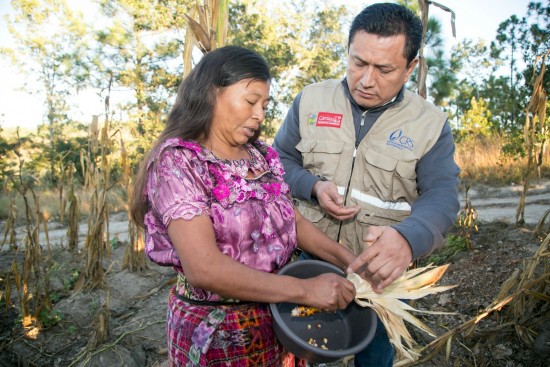Once a lush corn field in the Central Highlands of Guatemala, Cristina Garcia watched her crop turn into brittle ears of corn, leaving her little left to harvest. It’s the second year in a row that the rains have been scarce, this year’s drought is much worse than the last. Climate change and El Niño have combined to devastate the country’s already arid Dry Corridor, leaving farming families like Cristina, her husband Porfirio, and their seven children struggling to survive. On average, families in Guatemala’s Dry Corridor lost 70 percent of their crops this year, up from 30 percent last year as conditions compound and worsen.There are ways farmers like Cristina can adapt but she can’t do it without some help. Catholic Relief Services (CRS) has a long history of helping farmers grow better crops and find markets for what they produce.
Standing in the field with Cristina is CRS’ Humberto Monroy. They are picking apart an ear of corn to assess the impact of low rainfall on her crop. CRS has since taught Cristina crop adaption techniques and installed a water catchment system to help her collect rainwater runoff. Until circumstances improve, however, she and Porfirio will be forced to keep searching for work as day laborers in other places, hoping to make ends meet.
See more photos of farmers in Guatemala here: Living on the Edge of Climate Change | CRS.
Copyright 2016 Catholic Relief Services
In Guatemala, El Niño is creating dire need among farmers in an area called the Dry Corridor. Much of CRS’ work related to El Niño and climate related challenges is to help address and adapt to conditions by providing drought resistant crop seeds and preserving water.
About the Author

Catholic Relief Services
Catholic Relief Services is the official international humanitarian agency of the Catholic community in the United States. We are the official overseas relief and development agency of the U.S. Conference of Catholic Bishops and a member of Caritas International and the National Catholic Development Conference. Find us on Facebook, Twitter, YouTube, Google Plus and Pinterest.



.png?width=1806&height=731&name=CatholicMom_hcfm_logo1_pos_871c_2728c%20(002).png)
Comments